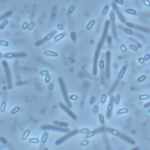Link to Pubmed [PMID] – 9663674
Mol. Microbiol. 1998 Jun;28(5):865-74
Several operon-specific transcriptional regulators, including antiterminators and activators, contain a duplicated conserved domain, the PTS regulation domain (PRD). These duplicated domains modify the activity of the transcriptional regulators both positively and negatively. PRD-containing regulators are very common in Gram-positive bacteria. In contrast, antiterminators controlling beta-glucoside utilization are the only functionally characterized members of this family from gram-negative bacteria. PRD-containing regulators are controlled by PTS-dependent phosphorylation with different consequences: (i) In the absence of inducer, the phosphorylated EIIB component of the sugar permease donates its phosphate to a PRD, thereby inactivating the regulator. In the presence of the substrate, the regulator is dephosphorylated, and the phosphate is transferred to the sugar, resulting in induction of the operon. (ii) In gram-positive bacteria, a novel mechanism of carbon catabolite repression mediated by PRD-containing regulators has been demonstrated. In the absence of PTS substrates, the HPr protein is phosphorylated by enzyme I at His-15. This form of HPr can, in turn, phosphorylate PRD-containing regulators and stimulate their activity. In the presence of rapidly metabolizable carbon sources, ATP-dependent phosphorylation of HPr at Ser-46 by HPr kinase inhibits phosphorylation by enzyme I, and PRD-containing regulators cannot, therefore, be stimulated and are inactive. All regulators of this family contain two copies of PRD, which are functionally specialized in either induction or catabolite repression.

